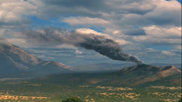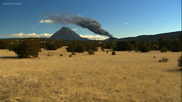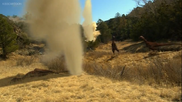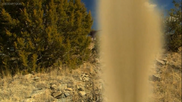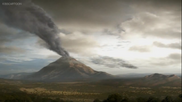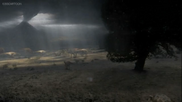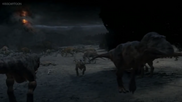
The Elkhorn Range as seen in Little Das' Hunt.
| “ | Yet the Elkhorn eruption ranks as one of the powerful ever recorded. By comparison Mount Saint Helens was a mere firecracker. | ” |
— Scott Sampson describing the eruption.
| ||
The Elkhorn Range are a section of the Rocky-Mountains in northwestern-Montana. They appear in the episode "Little Das' Hunt".
Details[]
Formerly volcanoes back in the cretaceous, they are dead-volcanoes today. This system of volcano's have been named the Elkhorn Volcanics.
In Dinosaur Planet[]
The Elkhorn Range were volcanoes bordering the Two Medicine Formation, often providing a fertile land for plants to live, however they were very active too: groundwater was often heated by rising magma and would often burst from the ground or from rocky-cliffs, occasionally killing any creature unlucky enough to get in the way (which happened to be a Troodon and several Quetzalcoatlus). The frequent seismic-activity also caused volcanic gases,including sulfur dioxide, to bubble in a waterhole where a herd of Orodromeus were residing. The volcanic activity was limited to the upland-areas, but were foreshadows of the impending disaster approaching. The only warning the lowland dinosaurs, which were 50 miles away from the volcanoes, got was the ash that was constantly rising from the volcanoes in the distance. While there were multiple volcanoes at once, some were ousted by others: one bigger volcano was linked to a smaller one, and the smaller one died. Some time later the bigger volcano began erupting, creating a large ash cloud which spreads across the landscape by a great diameter, cutting off sunlight while raining volcanic-glass and soot in the process. The lowland animals, and presumably the highland animals, didn't see this as a threat and continued with their daily lives for now, for this was only the beginning. After a while the soot stopped falling but the volcano continued to erupt. When it finally reached its peak, lava started bleeding from side vents and flowed down the mountain. Then explosions of magma started ripping through the crater, creating a lava fountain. This launched marble sized volcanic-cinders into the air which bombarded the highlands, setting off a few wildfires. Then larger explosions launched bigger and deadlier volcanic-boulders, one of which killed a Troodon . This did not extend to the lowlands and the dinosaurs didn't see it as a danger, but that wouldn't last for long. The worst came when the eastern-side of the volcano suddenly collapsed from the intense action of the magma and spawned a pyroclastic-flow, a superheated wave of ash, rock, and gas, which rolled over the landscape. It first sweeps over the highlands, destroying the forests and burning a Troodon alive. The flow then headed for the lowlands, 50 miles away. The dinosaurs that lived in the lowlands saw this as a threat and began running for their lives. But this wouldn't matter as the flow is way faster and it reaches the lowlands a few seconds later, killing a herd of Maiasaura and a family of Daspletosaurus (a herd of Einiosaurus are also presumably killed off-screen). The eruption was so massive it could be seen from earth's orbit, where it stretched to the Western-Interior-Seaway. 7 millions years later the landscape has recovered and the east part of the volcano is gone due to the collapse.
Trivia[]
- In the Palaeontology Segment, the elkhorn-eruption is said to be greater than Mount-Saint-Helens, meaning it would be more equal to Krakatoa or Mount Tambora making it around a 6 or 7 on the volcanic explosivity index.
- This is the largest natural disaster in the documentary.

